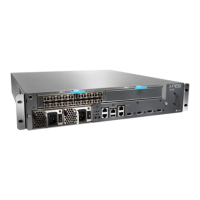Understanding the Host Subsystem
•
Host Subsystem Overview on page 368
•
M120, M320 T320, T640, T1600, TX Matrix, and TX Matrix Router Routing
Engines on page 369
•
M120, M320, T320, T640, T1600, TX Matrix, and TX Matrix Plus Router Control
Boards on page 371
Host Subsystem Overview
To replace the cable management system, see the appropriate router hardware guide.
Inspect the host subsystem to ensure that the Routing Engine and Control Board function
properly.
The host subsystem provides routing and system management functions on the M120,
M320, T320, T640, and T1600 routers. The host subsystem is comprised of two
components: the Routing Engine and the Control Board. For a host subsystem to function,
both of these components must be installed and operational.
The Routing Engine maintains the routing tables used by the router and controls the
routing protocols that run on the router.
The Control Board provides control and monitoring functions for the router—determining
Routing Engine mastership, controlling power, performing reset and SONET clocking for
the other router components, monitoring and controlling fan speed, and monitoring
system status using I2C controllers.
You can install one or two host subsystems on the router. You can install one or two
Routing Engines. The Routing Engines install into the upper rear of the chassis in the slots
labeled RE0 and RE1. If two Routing Engines are installed, one functions as master and
the other acts as backup. If the master Routing Engine fails or is removed, and the backup
is configured appropriately, the backup restarts and becomes master. The Routing Engines
are hot-pluggable. Each Routing Engine requires that a Control Board be installed in the
adjacent slot.
The Control Boards install into the upper rear of the chassis in the slots labeled CB0 and
CB1. If two Control Boards are installed, one functions as master and the other acts as
backup. If the master Control Board fails or is removed, the backup restarts and becomes
master. The Control Boards are hot-pluggable. Each Control Board requires a Routing
Engine to be installed in the adjacent slot. CB0 installs above RE0, and CB1 installs below
RE1. A Control Board does not function if no Routing Engine is present in the adjacent
slot.
Related
Documentation
Checklist for Monitoring the Host Subsystem on page 367•
Copyright © 2012, Juniper Networks, Inc.368
M Series and T Series Routers Monitoring and Troubleshooting Guide

